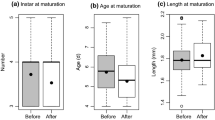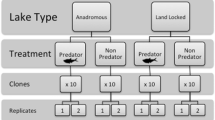Abstract
Dormant propagule pools (egg banks) of zooplankton populations that accumulate in sediments provide biological archives of past conditions and enable the investigation of evolutionary changes in populations over relatively long periods of time (many decades). This study examined the egg bank of a Daphnia pulicaria population in a lake that has been stocked annually with rainbow trout (a zooplanktivore) since 1961. Resting eggs from sediments from the 1920s to 2001 (determined by 210Pb dating) were hatched and established as isofemale clonal lines. The phototactic behavior (a proxy for vertical migration behavior) of clones was assessed in the presence and absence of fish kairomones to evaluate the hypothesis that the heavy and consistent level of predation imposed by the stocked trout would have selected for clones that are more negatively phototactic. In addition, exposure to kairomones was expected to induce stronger negative phototaxis for all clones relative to control conditions. The behavior of clones derived from resting eggs from the trout era (after 1961) was significantly more negatively phototactic than it was for pre-trout era clones. Kairomone exposure induced a more negative phototactic response in clones from both eras, but the response was much greater for the pre-trout era clones. These results suggest that the consistently high level of predation by trout over several decades has selected for a conservative (less plastic) vertical migration strategy in which Daphnia maintain a deep daytime distribution with or without the presence of chemical cues from fish predators.





Similar content being viewed by others
References
Appleby, P. G. & F. Oldfield, 1983. The assessment of 210Pb data from sites with varying sediment accumulation rates. Hydrobiologia 103: 29–35.
Cáceres, C. E., 1998. Interspecific variation in the abundance, production, and emergence of Daphnia diapausing eggs. Ecology 79: 1699–1710.
Cáceres, C. E. & N. G. Hairston Jr., 1998. Benthic-pelagic coupling in planktonic crustaceans: the role of the benthos. Ergebnisse der Limnologie 52: 163–174.
Cousyn, C., L. De Meester, J. K. Colbourne, L. Brendonck, D. Verschuren & F. Volckaert, 2001. Rapid, local adaptation of zooplankton behavior to changes in predation pressure in the absence of neutral genetic changes. Proceedings of the National Academy of Sciences of the United States of America 98: 6256–6260.
De Meester, L., 1991. An analysis of the phototactic behaviour of Daphnia magna clones and their sexual descendants. Hydrobiologia 225: 217–227.
De Meester, L., 1993. Genotype, fish-mediated chemical, and phototactic behavior in Daphnia magna. Ecology 74: 1467–1474.
De Meester, L., 1996. Evolutionary potential and local genetic differentiation in a phenotypically plastic trait of a cyclical parthenogen, Daphnia magna. Evolution 50: 1293–1298.
De Meester, L. & H. De Jager, 1993. Hatching of Daphnia sexual eggs. I. Intraspecific differences in the hatching responses of D. magna eggs. Freshwater Biology 30: 219–226.
Dean, W. E. Jr., 1974. Determination of carbonate and organic matter in calcareous sediments and sedimentary rocks by loss on ignition: comparison with other methods. Journal of Sedimentary Petrology 44: 242–248.
Decaestecker, E., L. De Meester & D. Ebert, 2002. In deep trouble: habitat selection constrained by multiples enemies in zooplankton. Proceedings of the National Academy of Sciences of the United States of America 99: 5481–5485.
Decaestecker, E., S. Gaba, J. A. M. Raeymaekers, R. Stoks, L. V. Kerckhoven, D. Ebert & L. De Meester, 2007. Host–parasite ‘Red Queen’ dynamics archived in pond sediment. Nature 450: 870–873.
Eakins, J. D. & R. T. Morrison, 1978. A new procedure for the determination of lead-210 in lake and marine sediments. International Journal of Applied Radiation and Isotopes 29: 531–536.
Ellner, S. P. & N. G. Hairston Jr., 1994. Role of overlapping generations in maintaining genetic variation in a fluctuating environment. American Naturalist 143: 403–417.
Hairston, N. G. Jr. & L. De Meester, 2008. Daphnia paleogenetics and environmental change: deconstructing the evolution of plasticity. International Review of Hydrobiology 93: 578–592.
Hairston, N. G. Jr., S. Ellner & C. M. Kearns, 1996. Overlapping generations: the storage effect and the maintenance of biotic diversity. In Rhodes, O. E. J., R. K. Chesser & M. H. Smith (eds), Population Dynamics in Ecological Space and Time. University of Chicago Press, Chicago: 109–145.
Hairston, N. G. Jr., W. Lampert, C. E. Cáceres, C. L. Holtmeier, L. J. Weider, U. Gaedke, J. M. Fischer, J. A. Fox & D. M. Post, 1999. Rapid evolution revealed by dormant eggs. Nature 401: 446.
Hebert, P. D. N., 1995. The Daphnia of North America: an illustrated fauna (computer program). AuthorWare.
Hembre, L. K. & R. O. Megard, 2005. Timing of predation by rainbow trout controls Daphnia demography and the trophic status of a Minnesota lake. Freshwater Biology 50: 1064–1080.
Hembre, L. K. & R. O. Megard, 2006. Direct and indirect effects of predation on the genetic structure of a Daphnia population. Journal of Plankton Research 28: 1129–1141.
Kerfoot, W. C. & L. J. Weider, 2004. Experimental paleoecology (resurrection ecology): chasing Van Valen’s Red Queen hypothesis. Limnology and Oceanography 49: 1300–1316.
Kerfoot, W. C., J. A. Robbins & L. J. Weider, 1999. A new approach to historical reconstruction: combining descriptive and experimental paleolimnology. Limnology and Oceanography 44: 1232–1247.
Lampert, W., W. Fleckner, H. Rai & B. E. Taylor, 1986. Phytoplankton control by grazing zooplankton: a study on the spring clear-water phase. Limnology and Oceanography 31: 478–490.
Latta, L. C., J. W. Bakelar, R. A. Knapp & M. E. Pfrender, 2007. Rapid evolution in response to introduced predators II: the contribution of adaptive plasticity. BMC Evolutionary Biology 7: 21.
Loose, C. J. & P. Dawidowicz, 1994. Trade-offs in diel vertical migration by zooplankton: the costs of predator avoidance. Ecology 75: 2255–2263.
Pangle, K. L. & S. D. Peacor, 2006. Non-lethal effect of the invasive predator Bythotrephes longimanus on Daphnia. Freshwater Biology 51: 1070–1078.
Pauwels, K., L. De Meester, S. Put, E. Decaestecker & R. Stoks, 2010. Rapid evolution of phenoloxidase expression, a component of innate immune function, in a natural population of Daphnia magna. Limnology and Oceanography 55: 1408–1415.
Peckarsky, B. L., A. R. Mcintosh, B. W. Taylor & J. Dahl, 2002. Predator chemicals induce changes in mayfly life history traits: a whole-stream manipulation. Ecology 83: 612–618.
Peckarsky, B. L., P. A. Abrams, D. I. Bolnick, L. M. Dill, J. H. Grabowski, B. Luttbeg, J. L. Orrock, S. D. Peacor, E. L. Preisser, O. J. Schmitz & G. C. Trussell, 2008. Revisiting the classics: considering nonconsumptive effects in textbook examples of predator–prey interactions. Ecology 89: 2416–2425.
R Development Core Team, 2011. R: a language and environment for statistical computing. R-Foundation for Statistical Computing. Vienna, Austria. http://www.R-project.org.
Rudstam, L. G., R. C. Lathrop & S. R. Carpenter, 1993. The rise and fall of a dominant planktivore: direct and indirect effects on zooplankton. Ecology 74: 303–319.
Schmitz, O. J., A. P. Beckerman & K. M. O’Brien, 1997. Behaviorally mediated trophic cascades: effects of predation risk on food web interactions. Ecology 78: 1388–1399.
Schwartz, S. S. & P. D. N. Hebert, 1987. Methods for the activation of resting eggs of Daphnia. Freshwater Biology 17: 373–379.
Steiner, C. F., C. E. Caceres & S. D. Smith, 2007. Resurrecting the ghost of competition past with dormant zooplankton eggs. American Naturalist 169: 416–422.
Wang, L., K. Zimmer, P. Dietrich & S. Williams, 1996. The two-story rainbow trout fishery and its effect on the zooplankton community in a Minnesota lake. Journal of Freshwater Biology 11: 67–80.
Acknowledgments
Financial support for this research was provided by the Hamline University Lund Fund and the National Science Foundation (DIGG Grant #0105009). We are very grateful to Dan Engstrom (Science Museum of Minnesota St. Croix Watershed Research Station) for performing the 210Pb dating of the sediment core, to Brian Johnson and Doug Schnurrenburger for their assistance in coring Long Lake, to Emily Walsh and Rebecca Forman for help with the hatching experiments, to Frank Shaw for advice on statistical analyses, and to Robert Sterner for providing access to his laboratory at the University of Minnesota. Lastly, we thank Robert Megard for his consultation at various stages of this research.
Author information
Authors and Affiliations
Corresponding author
Additional information
Handling editor: Jasmine Saros
Rights and permissions
About this article
Cite this article
Hembre, L.K., Peterson, L.A. Evolution of predator avoidance in a Daphnia population: evidence from the egg bank. Hydrobiologia 700, 245–255 (2013). https://doi.org/10.1007/s10750-012-1234-6
Received:
Revised:
Accepted:
Published:
Issue Date:
DOI: https://doi.org/10.1007/s10750-012-1234-6




